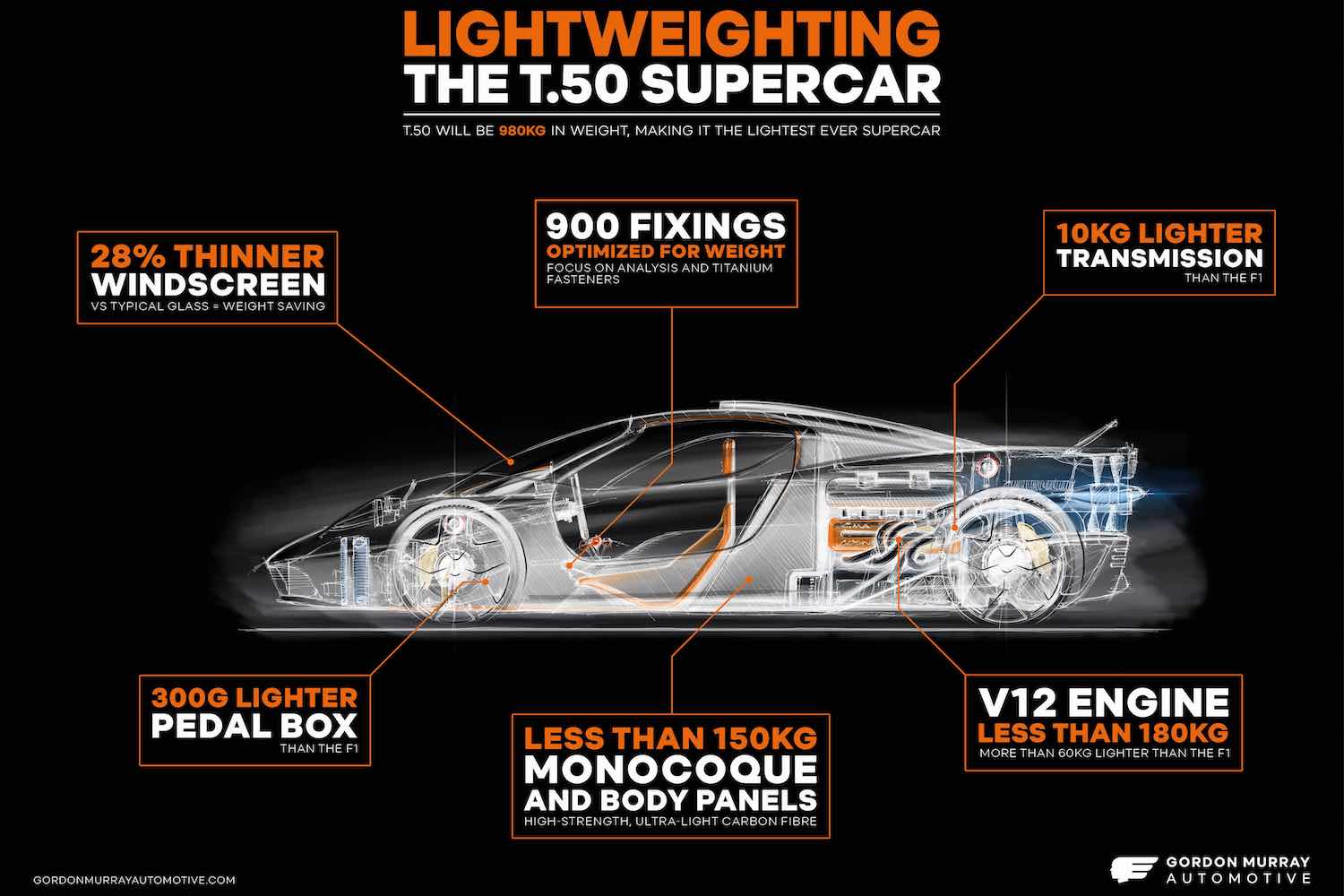Ever since it was announced last year, the Gordon Murray Automotive (GMA) T.50 supercar has been generating a lot of excitement, especially after we got our first glimpse of it at the end of 2019. Now, Professor Murray has been explaining how the T.50 achieves one of its most eye-widening stats: a kerb weight of just 980kg.
The light fantastic
Citing the typical weight of a comparable supercar as being 1,436kg (a figure arrived at by averaging out the mass of Autocar's 'Top 10 Supercars for 2020'), to hack an entire third off that number requires a fastidious attention to detail. Luckily, in Prof. Murray, the GMA team has someone to whom the word 'fastidious' might be considered to be slightly underplaying things somewhat. Murray has always had a singular focus on reducing the weight of any vehicle he builds or works on, rather than dolloping in more power to compensate for the automotive equivalent of middle-aged spread, and the T.50 is the epitome of this lifelong ethos.
He said: "Designing a lightweight sports car does not come from specifying exotic materials alone, it comes from a state of mind, from absolute focus and control, and from a deep understanding of lightweight, optimised design." Part of the key to this is that Prof. Murray thinks of data in terms of 'weight-to-power', rather than the rather more commonplace 'power-to-weight'.
Thus, in the T.50, every 100hp is only propelling 150kg of car, whereas in the 'typical supercar' of 1,436kg, its mean 684hp results in 100hp-to-210kg - a figure 40 per cent higher than that of the GMA. And this is a self-reciprocating thing: in order to match the T.50's 663hp-per-tonne, the 1,436kg typical supercar would need another 300hp for a grand total of 950hp or thereabouts. But once you start dealing with 950hp, then you have to add more cost to the project, while the car would also need larger, heavier components (tyres, drivelines, transmission, brakes and so on) to deal with such power.
'Enjoyment of driving lost in other supercars'
Prof. Murray, therefore, believes a heavier car can never deliver the attributes of a lighter car, even if they both have exactly the same power-to-weight ratio. Complex active suspension and sophisticated electronics can mask the mass of the bulkier vehicle, but it will never have the agility, responsiveness and reward of a lightweight machine. And, if you think this all sounds familiar, then know that Murray is a devout advocate of former Lotus boss Colin Chapman's famous mantra of 'simplify, then add lightness'.
Prof. Murray added: "Today, the enjoyment of driving has been lost as so many supercars only come 'alive' at the upper ends of their performance capabilities. Chasing a top speed only adds weight (notably through ever-more powerful engines), so the future of true performance cars lies in shedding weight intelligently."
Head-spinning brick count
The T.50 achieves its lightness through a number of means. At 4,380mm long and 1,850mm wide, it's smaller than a Porsche 911 but manages to offer space for three passengers and luggage. With a fully carbon-fibre monocoque and body panels, the whole car's frame weighs less than 150kg in total. Those three seats inside are made of carbon, too, so the driver's seat weighs 7kg while the two passenger seats clock in at less than 3kg apiece.
Then there's the engine. It's a normally aspirated V12 that revs to 12,100rpm and produces 650hp, but this 4.0-litre unit doesn't exceed 180kg; that means it's the lightest road-going V12 ever made and more than 60 kilos trimmer than the legendary S70/2 V12 used in the McLaren F1 of the 1990s. A total of 900 fixings throughout the GMA T.50, such as nuts, bolts and washers, are trimmed of unnecessary flab and are designed to be specific to their application, rather than generic throughout the vehicle as they would be in any other supercar. Even the pedal box in the T.50 is 300g lighter than that found in the Macca F1, while the glazing in the glasshouse is 28 per cent thinner than usual applications in other cars.

